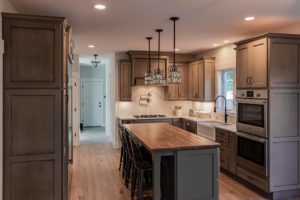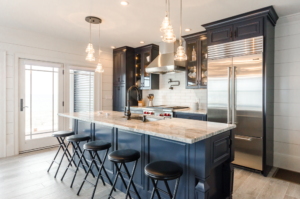Color isn’t the only way to add visual design elements to a kitchen. Professional designers will tell you that a well-designed kitchen layers textures and patterns in a complementary way. Find out below how you can use this technique in your own kitchen design.

Wood is one of the easiest natural textures to incorporate into a kitchen design. Hardwood flooring, wood ceiling beams, butcher block countertops, and even open wooden shelving can instantly provide warmth and ground a space. Because different species offer unique textures, layering one type of wood on another can create beautiful contrast.
Metal
The use of mixed metals in kitchen design is a trend to look out for next year. In the meantime, you can add metal features into your design with an oversized metal range hood, cabinet hardware, lighting fixtures, and your choice of faucet. The industrial nature of metal paired with the natural textures of wood can make an appealing contrast.
Porcelain
Porcelain may bring thoughts of modern farmhouse style but contrasted with the textures listed above among others, porcelain can seem modern too. Two of the easiest ways to incorporate this classic material are via backsplash tiles or an apron sink.

Large medium-tone hardwood floor, eat-in kitchen design near Boston with a farmhouse sink, stainless steel appliances, two islands, Dekton quartz countertop in Trillium Color, and Kraftmaid raised-panel Marquette cabinets in colors Onyx (Black) and Aged Concrete (gray).

Large medium-tone hardwood floor, eat-in kitchen design near Boston with a farmhouse sink, stainless steel appliances, two islands, Dekton quartz countertop in Trillium Color, and Kraftmaid raised-panel Marquette cabinets in colors Onyx (Black) and Aged Concrete (gray).
Other
There are so many other ways to add dimension and texture to your kitchen design. A few more popular ideas are an exposed brick wall or backsplash, a beadboard kitchen island, and big beautiful stone countertops. Don’t be afraid to mix and match. Get samples of the products you want and hold them up together to see how they complement each other. If you still need some professional help, the experienced designers at Fairview Millwork and Kitchens are always at your service.





